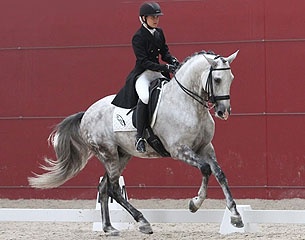
We have all seen dressage pairs who make it look like too much hard work! They leave the arena in a sweaty mess on board a horse that looks like he has just taken a 2-hour cat nap. My idol Nuno Oliviera used to encourage riders to work hard by thinking, not through the use of physical effort!
To achieve lightness and balance a rider must set up the parameters and then let the horse continue alone. The minute you become quiet on top of the horse and he stops, loses impulsion, or runs off back to the stable, chances are you having been riding him every step (defined as the rider having to physically push or pull the horse with every stride to maintain the rhythm and cadence)!
There is a huge difference between “controlling every step” and “riding every step”, as controlling requires an equestrian tact that enables the rider to maintain the corridor and allows the horse to move freely within it. That means the rider must have balance and fluidity in his seat, but it does not mean that he needs to physically hold or push the horse with every stride. You can see the difference very clearly!
A rider who controls every step will give an aid, get a reaction, then controls that reaction by not abandoning the horse, but reassures him by becoming a gracious bubble on his back. A rider that rides every step will give an aid and get a little or a non-existent response, so then he asks again, and again, and again, until the rider is forced to continually demand and pump the horse's impulsion instead of creating a sphere in which he will “impulse” himself!
This begins even before the rider sits in the saddle. When you lead your horse do you drag him along, or do you give a quick tug on the rope, and then he walks with you, not after you? Then, the minute you get in the saddle, do you give him a light touch with the leg and he moves off, or do you stand for a good 30 seconds kicking at him until he finally decides to step out of the stables?
Entering the arena, the horse should walk alone and the rider should touch him up, and then “control” the walk, but not continually demand the horse to move forward.
The alternative is also just as apparent and we often see riders who need to pull, pull, pull just to keep the horse in control! If the horse is running at the walk, the rider should give the aid for the horse to come back and then release the aid without giving the control away!
Often we fall into the trap where we feel that forward means giving the reins awa and instead of creating impulsion and engagement we let the horse fall forward onto the shoulders. Going forward relies on the rider’s ability to control the forward motion through elastic aids and a giving but not an abandoning rein!
If the rider gives the rein away the forward energy is lost in a downward direction in front and the rider will need to continue the forward aid over and over to keep the horse's momentum. A rider that asks impulsion and then channels that impulsion into an elastic contact will be able to regenerate that energy and allow the horse to work on his own. While the rider will still control the horse's power with a balanced seat, he will not have to keep on creating new energy over and over because he gave that energy away.
Dressage should look like a classical art, not a cardiovascular workout, so if you feel like you are working harder than your horse, ask yourself whether your aids are effective; ask whether you catch the energy you create or whether you let it go, and ask if you control that energy, or ask for it every step?
by Sarah Warne